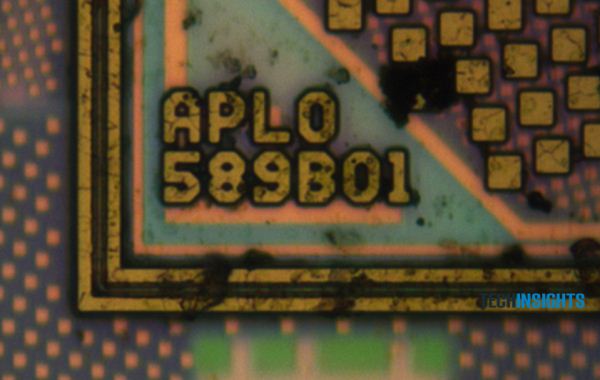Apple A6 Die Revealed: 3-core GPU, < 100mm^2
by Anand Lal Shimpi on September 21, 2012 4:00 PM EST- Posted in
- SoCs
- Apple
- Smartphones
- Mobile
- iPhone 5
Our good friends at UBM TechInsights sent over the first diffusion images of Apple's new A6 SoC. It's still too early to tell a lot but we have confirmation of a lot of things. The image above shows two 32-bit LPDDR2 memory channels and three GPU cores. We're likely looking at a PowerVR SGX 543MP3 running at 266MHz.
UBM estimates the die size at 95.04mm2 and the manufacturer as Samsung.
We'll have more details about the A6 and its performance shortly.
Source: UBM TechInsights














60 Comments
View All Comments
name99 - Friday, September 21, 2012 - link
It's not memory, it's various other bits and pieces. There'll be hardware there to signal process images from the camera. There'll be an h.264 encode and decode engine. There'll be a block to play audio (so everything else can sleep while music plays). There'll be a memory controller. etc etcThe actual 1GB memory will be on a separate chip mounted in close proximity to this chip, but fabricated separately, using different processes.
What I am curious about is the green fungus on everything. Is that an imaging artifact, a consequence of how the cover was scraped off the chip, or what?
Loki726 - Friday, September 21, 2012 - link
The "green fungus" is automatically synthesized logic, perhaps from a high level model of video decoder engine. See my above post.Zink - Friday, September 21, 2012 - link
Wow. That is truly amazing. So the computer optimized transistors are almost organic in organization?Loki726 - Friday, September 21, 2012 - link
They use a combination of heuristics for constraint (SAT) solvers and machine learning algorithms (particle swarm, genetic evolution, or neural networks).They easily beat hand layout by people.
Loki726 - Friday, September 21, 2012 - link
The High-Level and Logic Synthesis track at The Design Automation Conference (DAC) http://www.dac.com/ gives a good overview of the current state of the art.KitsuneKnight - Friday, September 21, 2012 - link
That seems unlikely. Look close at any of the GPUs and you can see the patterns of the 'green fungus' looking stuff isn't the same between the different GPUs/cores. It's most likely a product of how they removed the casing from the chip, doing it quickly to get a shot out ASAP instead of taking time to properly clear it all away.Loki726 - Friday, September 21, 2012 - link
Maybe, but it does looks similar to what synthesis tools produce. See this figure of AMD steamroller for comparison: http://images.anandtech.com/doci/6201/Screen%20Sho...Loki726 - Friday, September 21, 2012 - link
Also, if it is a product of the casing then why doesn't it cover the CPU cores?Zink - Friday, September 21, 2012 - link
It is fairly similar between gpu cores. Image search "automatically synthesized logic silicon" and there are a few chips that have similarities. I think the CPU cores have an organic looking texture different from the fungus. Those for sure are optimized like this, maybe the fungus is just residue.Loki726 - Friday, September 21, 2012 - link
You can explain the different pattern for different GPU cores by them just running the tools once for each core. The whole point of these tools is that you don't want to just design a component once and then replicate it a bunch of times: you want to do global optimization.